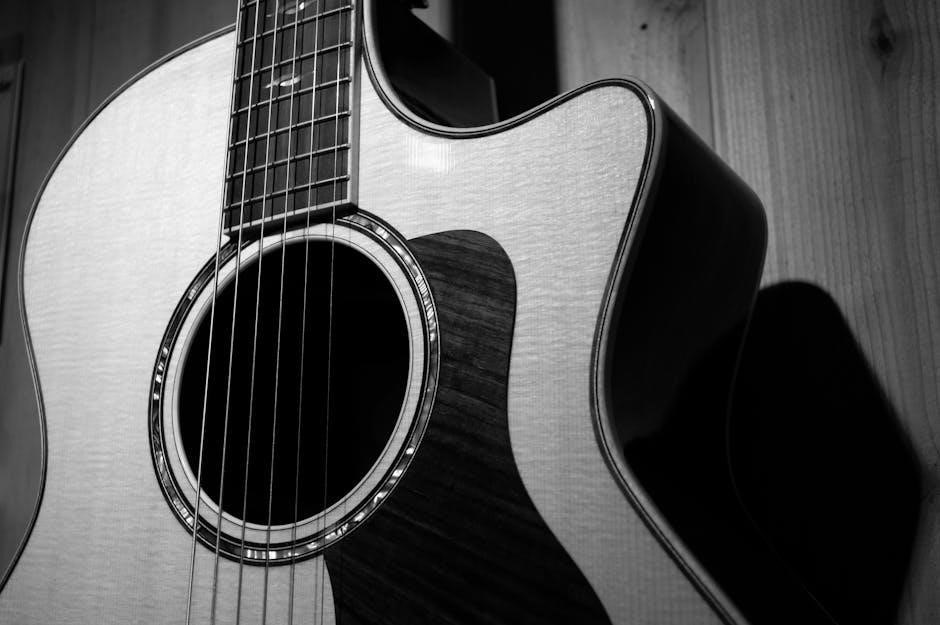Discover essential bass guitar chords with convenient PDF guides, featuring common chord shapes, arpeggios, and diagrams. These resources help musicians of all levels learn and master bass chords efficiently.
Importance of Chords in Bass Guitar Playing
Mastering bass guitar chords is fundamental for creating rich harmonies and structuring music. Chords provide the foundation for rhythm sections, enabling bassists to support melodies and define progressions. They are essential for playing in various genres, from rock to jazz. Understanding chord shapes and finger placements enhances versatility, allowing bassists to adapt to different musical styles. Chords also serve as a guide for crafting bass lines and solos, adding depth to compositions. Whether using a PDF chord chart or interactive tools, learning chords empowers bassists to contribute effectively to ensembles and explore advanced techniques. Chords are the building blocks of music, making them indispensable for every bass guitarist.
Overview of Common Bass Guitar Chords

Common bass guitar chords include major, minor, seventh, diminished, and augmented chords. These are foundational for most musical genres. Major and minor chords form the basis of harmonic structures, while seventh chords add complexity. Diminished and augmented chords provide unique tonal colors. Power chords, focusing on root and fifth, are popular in rock and punk. These chords are often visualized in PDF chord charts, which include diagrams and finger placements. Learning these shapes on the fretboard is crucial for versatility. They are essential for playing bass lines, solos, and contributing to ensemble performances. Whether starting with basics or exploring advanced techniques, mastering these chords is vital for every bassist.
Understanding Bass Guitar Chord Charts
A bass guitar chord chart is a visual guide displaying chord shapes and finger placements. It helps musicians learn and play chords efficiently by providing a clear layout of notes on the fretboard.

What is a Bass Guitar Chord Chart?
A bass guitar chord chart is a visual guide that displays chord shapes and finger placements on the fretboard. It provides a clear layout of notes, making it easier for musicians to learn and play chords efficiently. These charts often include major, minor, seventh, diminished, and augmented chords, along with diagrams and fingerings. They are available as downloadable PDFs, offering a convenient way to practice and master various chord shapes. Whether you’re a beginner or an advanced player, a bass guitar chord chart is an essential tool for understanding chord structures and improving your playing skills. It’s a straightforward resource to help you navigate the fretboard with confidence.
How to Read a Bass Guitar Chord Chart
Reading a bass guitar chord chart involves identifying the root note, suggested fingerings, and fret positions. The chart displays the fretboard layout, with dots representing where fingers should press the strings. Open circles indicate open strings, while an “X” marks muted or unfretted strings. Numbers beside dots show which fingers to use (e.g., 1 for index, 2 for middle). The root note, highlighted in orange, guides the chord’s tonality; By aligning the chart with your fretboard, you can replicate the chord shapes accurately. This visual system simplifies learning and playing chords, making it accessible for musicians of all skill levels to master bass guitar chords effectively.
Key Symbols and Notations Used in Chord Charts
Bass guitar chord charts use specific symbols and notations to guide players. Dots on the fretboard indicate where fingers should press the strings, while numbers represent fingerings (e.g., 1 for index, 2 for middle). Open circles denote open strings, and an “X” marks strings that should be muted or not played. The root note of the chord is often highlighted in a distinct color, such as orange, to emphasize the chord’s tonal center. Additional symbols like “O” for open strings and “T” for thumb positions may also appear. These visual cues, along with fret numbers and string labels, provide a clear and concise way to interpret and play bass guitar chords accurately.

Types of Bass Guitar Chords
Bass guitar chords include major, minor, seventh, diminished, augmented, and power chords. Each type offers unique tonal qualities, with diagrams and notes provided in PDF guides for easy learning.
Major Chords
Major chords are foundational in bass guitar playing, providing a bright, harmonic sound. They consist of a root note, a major third, and a perfect fifth. These chords are essential for creating uplifting melodies and progressions. PDF guides often include major chord diagrams, showcasing finger placements and fret positions. For example, a C major chord on bass involves playing the C note, E note, and G note. These chords are versatile and widely used across various musical genres. Practicing major chords helps build a strong harmonic foundation, enabling bassists to contribute effectively to band performances and compositions. Regular practice with chord charts ensures mastery of these fundamental shapes.
Minor Chords
Minor chords on the bass guitar create a somber, introspective sound, adding depth to musical compositions. They are structured with a root note, a minor third, and a perfect fifth. For instance, an A minor chord includes the notes A, C, and E. These chords are widely used in various genres to evoke emotional resonance. PDF guides often provide clear diagrams for minor chord shapes, making them easier to learn. Practicing minor chords enhances a bassist’s ability to contribute to melancholic or reflective pieces. Regular use of chord charts helps in mastering these shapes, ensuring smooth integration into bass lines and solos across different musical styles and genres.

Seventh Chords

Seventh chords on the bass guitar add a rich, complex sound to music, combining the root, third, fifth, and seventh notes. They are commonly used in jazz and blues to create tension and depth. For example, a G7 chord includes G, B, D, and F. These chords are versatile and can be played in various positions on the fretboard. PDF guides often include diagrams for seventh chords, making them easier to learn. Practicing seventh chords enhances a bassist’s ability to add emotional complexity to their playing. Regular use of chord charts helps in mastering these shapes, ensuring smooth integration into bass lines and solos across different musical styles and genres.
Diminished and Augmented Chords
Diminished and augmented chords on the bass guitar offer unique tonal colors, adding depth to musical compositions. A diminished chord consists of a root, minor third, and diminished fifth, creating a tense, unstable sound. Augmented chords, on the other hand, include a root, major third, and augmented fifth, producing a bright, expansive quality. Both are less commonly used than major or minor chords but are powerful tools for adding complexity. PDF guides often include diagrams for these chords, making them easier to learn. Practicing diminished and augmented chords expands a bassist’s harmonic palette, allowing for more nuanced and expressive playing in various musical contexts.

Power Chords
Power chords are essential for bass guitarists, particularly in rock, punk, and metal music. They consist of a root note and a perfect fifth, creating a strong, driving sound. These chords are versatile and often used in riffs and bass lines. On the bass guitar, power chords are typically played on the lower strings for maximum impact. PDF guides frequently include power chord diagrams, showing finger placements and fret positions. They are simple to learn but powerful in application, making them a cornerstone of many bassists’ arsenals. Mastering power chords enhances your ability to play dynamically and with authority, making them a must-learn for any serious bass player.
Advanced Bass Guitar Chords
Explore advanced bass guitar chords like 9th, 11th, and 13th for richer sounds. PDF guides offer detailed diagrams and fingerings for these complex chords.
Extended Chords (9th, 11th, 13th)
Extended chords like 9th, 11th, and 13th add depth and complexity to basslines. These chords include additional notes beyond the basic triad, creating richer harmonic textures. PDF guides provide detailed diagrams and fingerings for these advanced voicings, making them accessible to players of all levels. The 9th chord adds a bright, expansive sound, while the 11th and 13th chords introduce dissonant, jazzy tones. Learning these chords enhances versatility and allows bassists to explore intricate musical genres. With clear visuals and step-by-step instructions, PDF resources simplify the process of mastering extended chords, helping players expand their musical expression.
Altered Chords
Altered chords introduce unique tonal colors by modifying intervals within a chord. These chords, often used in jazz and fusion, add emotional depth to basslines. PDF guides offer detailed diagrams for altered chords, such as flat fifths, sharp fifths, and raised or lowered ninths. These resources help bassists understand how to play complex voicings with precision. Altered chords expand the harmonic palette, enabling players to create intricate, dynamic solos and lines. By mastering these advanced techniques, bassists can elevate their playing in various musical genres, from jazz to experimental rock. PDF charts provide clear fingerings, making altered chords accessible and easy to incorporate into your repertoire.
Modular Chord Shapes
Modular chord shapes simplify playing by breaking chords into smaller, movable patterns on the fretboard. These shapes allow bassists to adapt chords to different keys effortlessly. By focusing on root notes and intervals, players can construct chords dynamically. Modular shapes are versatile, enabling seamless transitions between chords and scales. They are particularly useful in genres like jazz and progressive rock, where complex harmonies are common. PDF guides often include modular diagrams, providing clear fingerings and fretboard layouts. Mastering these shapes enhances improvisation and composition skills, making them indispensable for advanced bassists seeking to expand their musical expression and versatility across various styles and techniques.

Practical Applications of Bass Guitar Chords
Mastering bass guitar chords enhances playing in various genres, from rock to jazz. Use chords to create dynamic bass lines, solos, and practice progressions. PDF guides provide essential shapes and techniques for real-world application, helping musicians improve their skills and adapt to different musical styles effectively.
Playing Chords in Different Musical Genres
Bass guitar chords are versatile and essential for playing various musical genres. In rock and pop, power chords and fifths dominate, providing a solid rhythmic foundation. Jazz often incorporates extended chords like 7ths and 9ths for complex harmonies. Funk and R&B rely on slapping and popping techniques combined with chordal grooves. Blues music uses minor and diminished chords to create soulful, emotive lines. Downloadable PDF guides offer chord shapes tailored to these styles, helping bassists adapt to genre-specific demands. Mastering these techniques allows players to seamlessly transition between genres, enhancing their musical versatility and creativity. Whether it’s rock, jazz, or funk, chords are the backbone of dynamic bass playing.
Using Chords in Bass Lines and Solos
Bass guitar chords are fundamental for crafting dynamic bass lines and solos. By breaking chords into arpeggios, players create melodic lines that highlight harmonic structure. In solos, chord tones (root, 3rd, 5th, 7th) serve as key melodic points, adding emotional depth. Using chordal shapes, bassists can play rhythmic chords to drive the groove. For example, in rock and funk, chordal slapping and popping techniques add percussive flair. Downloadable PDF guides provide chord diagrams and arpeggio patterns, helping players integrate these techniques seamlessly. Mastering chord-based lines and solos enhances a bassist’s ability to contribute meaningfully to a song’s structure and feel, making them a versatile and essential part of any band;
Chord Progressions for Practice
Chord progressions are essential for mastering bass guitar chords. Downloadable PDF guides offer structured progressions, starting with simple sequences like C-G-Am-F and advancing to complex harmonic movements. These exercises help build finger strength, improve timing, and enhance musicality. Progressions often include major, minor, and seventh chords, allowing players to explore various harmonic contexts. Practicing arpeggios within these progressions strengthens understanding of chord tones and their relationships. Additionally, rhythmic variations, such as playing with a metronome or experimenting with syncopation, add depth to your practice routine. Regularly working through these progressions ensures a solid foundation in bass guitar chords and their practical application in music.

Resources for Learning Bass Guitar Chords
Download free PDF guides and interactive charts for mastering bass guitar chords. These resources include diagrams, finger placements, and exercises for all skill levels to improve your playing.
Best PDF Guides for Bass Guitar Chords

Download comprehensive PDF guides featuring essential bass guitar chords, including major, minor, seventh, diminished, and augmented chords. These guides provide clear diagrams, finger placements, and arpeggios to help musicians master chord shapes. Perfect for all skill levels, the PDFs include detailed fretboard layouts and suggested fingerings. They are ideal for printing and practicing, offering a structured approach to learning. Many guides also cover advanced techniques and extended chords, making them versatile for both beginners and experienced players. These resources are indispensable for improving your bass guitar skills and expanding your musical versatility across various genres.
Recommended Online Tools and Apps
Enhance your bass guitar learning journey with top-rated online tools and apps. Platforms like Fender Play and Yousician offer interactive lessons and exercises tailored for bassists. These apps provide note-by-note breakdowns, chord progressions, and real-time feedback to improve accuracy. Additionally, websites such as TrueFire and Guitar Tricks feature extensive libraries of bass-specific courses and chord tutorials. Many apps include customizable chord charts, allowing you to focus on specific chords or genres. They also offer progress tracking, helping you stay motivated and consistent in your practice. These digital resources are perfect for modern learners, offering flexibility and accessibility to master bass guitar chords and expand your musical skills effectively.
Books and Tutorials for Advanced Learning
For in-depth mastery of bass guitar chords, explore comprehensive books and tutorials designed for advanced players. Titles like “The Bass Handbook” by Tony Skinner and “Bass Guitar For Dummies” by Patrick Pfeiffer offer detailed chord theory and techniques. These resources cover extended chords, arpeggios, and complex progressions, providing a solid foundation for advanced learning. Additionally, video tutorials and masterclasses on platforms like TrueFire and ArtistWorks feature lessons from renowned bassists, focusing on intricate chord shapes and their practical applications. These materials are ideal for musicians seeking to refine their skills and explore advanced chord voicings in various musical genres.
Mastering bass guitar chords opens endless musical possibilities. With consistent practice and the right resources, such as PDF guides and tutorials, you can achieve proficiency and creativity.
Final Tips for Mastering Bass Guitar Chords
Consistent practice is key to mastering bass guitar chords. Start with basic shapes and gradually progress to more complex ones. Use PDF chord charts to visualize finger placements and notes. Break chords into arpeggios for smoother transitions. Focus on clean, clear tones by ensuring proper finger placement and string pressing. Practice switching between chords rhythmically to build muscle memory. Explore different genres to apply your chord knowledge. Experiment with extended chords and altered tones for a richer sound. Use tools like tuners and metronomes to improve accuracy and timing. Stay patient, as mastery takes time. Celebrate small progress and keep pushing forward.
Encouragement to Keep Practicing
Embrace the journey of learning bass guitar chords with enthusiasm and dedication. Every practice session brings you closer to mastery. Utilize PDF chord charts to track your progress and stay motivated. Celebrate small victories, like mastering a new chord shape or transitioning smoothly between chords. Remember, consistent practice strengthens finger dexterity and builds confidence. Set achievable goals, such as learning one new chord per week, and reward yourself for milestones reached. Experiment with different musical genres to apply your chord knowledge creatively. Keep in mind that mastery takes time, but the rewards of playing your favorite tunes are well worth the effort. Stay inspired, and let your passion for music guide you forward.

Be First to Comment